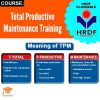Statistical Process Control
Original price was: RM1,300.00.RM850.00Current price is: RM850.00.
 |
IntroductionThe course educates participants on the theory and application of SPC concepts which are today being recognized as fundamental in Process Management and Improvement. This course is designed in a manner where the requirements of statistics are minimized and practical examples maximized. At the end of the course, participants should be able to set up the Control Charts and interpret histograms for determining CP and CPK value. How Will You BenefitUpon completion of this programme, the participants will be able to:
Who Should AttendThis course is suitable for executives and supervisors either currently or about to implement Statistical Process control in their work environment. Ability to use calculator with Standard Deviation Function is required. MethodologyThis course involves a wide range of learning approaches, including self – assessment, case studies, small group activities, discussions, interactive lectures, experimental learning group assignments, exercises and presentation and critique. Module
|
Fee: RM 850 per pax
Loyalty Points: 850 Points
Duration: 1 Day
Note: In-house course is available. Request it HERE
Trainer
Tejwinder Singh A/L Jujar Singh
With 25 years in management system development, Tejwinder is a much sought after trainer for ISO 9001, ISO 14001, OHSAS 18001 and ISO/TS 16949 ; having trained over 50,000 personnel worldwide. As a pioneer in ISO/TS 16949 quality system management development in Malaysia and Lead Tutor for IRCA approved Lead Auditor Training, Tejwinder has helped numerous organizations implement the QS 9000 and ISO/TS 16949. As a Certified Lean Six Sigma Black Belt, he presents training on Total Quality Management, Six Sigma, Lean Management, 7QC Tools, Root Cause Analysis, Innovative and Improvement Circles, Cost of Quality, Supplier Quality Management, 5S, APQP/PPAP, FMEA, SPC, MSA, 8D Problem Solving, Poka Yoke and other quality audit awareness programmes. He was involved in the assessment of TNB divisions for the TNB’s Presidential TQM Award.



